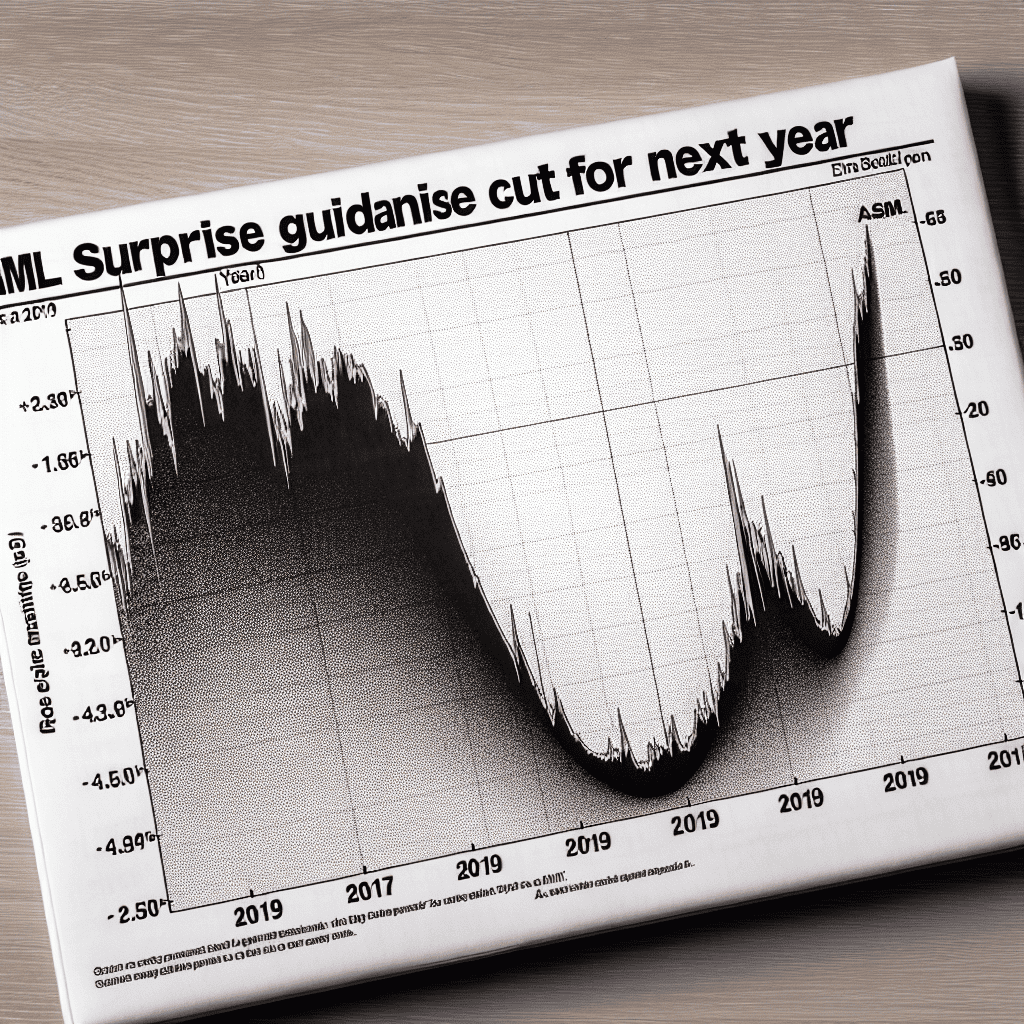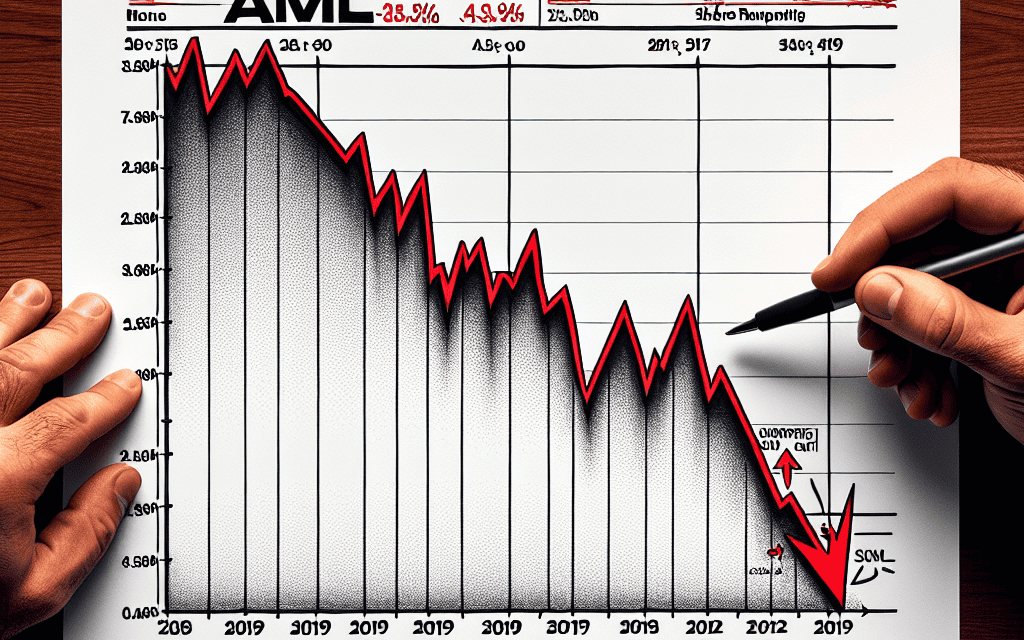“ASML Shares Tumble: Navigating Uncertainty with a Surprise Guidance Cut”
Introduction
ASML Holding NV, a leading supplier in the semiconductor industry, recently experienced a significant drop in its share value following an unexpected revision of its financial guidance for the upcoming year. The Dutch company, renowned for its advanced lithography machines essential for chip manufacturing, announced a downward adjustment in its revenue projections, citing a combination of macroeconomic uncertainties and shifting demand dynamics within the semiconductor sector. This surprise guidance cut has raised concerns among investors about the potential impact on ASML’s growth trajectory and the broader implications for the global technology supply chain. The market’s reaction underscores the sensitivity of tech stocks to fluctuations in demand forecasts and the intricate challenges faced by companies operating in this rapidly evolving industry.
Impact Of ASML’s Guidance Cut On The Semiconductor Industry
ASML Holding NV, a pivotal player in the semiconductor industry, recently sent ripples through the market with an unexpected guidance cut for the upcoming year. This announcement has not only led to a significant plunge in ASML’s share prices but has also raised concerns about the broader implications for the semiconductor sector. As the industry grapples with this development, it is crucial to understand the potential impact on various stakeholders, including manufacturers, suppliers, and investors.
To begin with, ASML’s role as a leading supplier of photolithography machines, particularly its cutting-edge extreme ultraviolet (EUV) lithography systems, positions it at the heart of semiconductor manufacturing. These machines are essential for producing the most advanced chips, which power everything from smartphones to data centers. Consequently, any changes in ASML’s outlook can have far-reaching effects on the entire supply chain. The guidance cut suggests a potential slowdown in demand for these high-tech machines, which could signal a broader deceleration in the semiconductor industry’s growth trajectory.
Moreover, the semiconductor industry has been navigating a complex landscape marked by fluctuating demand, geopolitical tensions, and supply chain disruptions. ASML’s revised guidance adds another layer of uncertainty, prompting manufacturers to reassess their production strategies. Companies that rely heavily on ASML’s technology may need to adjust their investment plans, potentially delaying or scaling back their expansion projects. This could lead to a ripple effect, impacting suppliers of raw materials and components, as well as other equipment manufacturers.
In addition to affecting manufacturers, ASML’s guidance cut has significant implications for investors. The semiconductor sector has been a focal point for investors seeking growth opportunities, driven by the increasing demand for digital products and services. However, the recent downturn in ASML’s shares may prompt a reevaluation of investment strategies. Investors might become more cautious, scrutinizing the financial health and growth prospects of semiconductor companies more closely. This shift in sentiment could lead to increased market volatility, as investors weigh the risks and rewards of maintaining their positions in the sector.
Furthermore, the guidance cut raises questions about the long-term outlook for the semiconductor industry. While the sector has experienced robust growth in recent years, driven by technological advancements and the proliferation of connected devices, it is not immune to cyclical downturns. ASML’s announcement may serve as a reminder of the industry’s inherent volatility, prompting stakeholders to consider the potential challenges that lie ahead. These challenges include navigating supply chain complexities, managing geopolitical risks, and addressing environmental concerns associated with semiconductor manufacturing.
Despite these challenges, it is important to recognize that the semiconductor industry remains a cornerstone of the global economy. The demand for semiconductors is expected to continue growing, fueled by emerging technologies such as artificial intelligence, 5G, and the Internet of Things. As such, while ASML’s guidance cut may present short-term hurdles, the long-term prospects for the industry remain promising. Companies that can adapt to the evolving landscape and innovate in response to changing market dynamics are likely to emerge stronger.
In conclusion, ASML’s surprise guidance cut has undoubtedly cast a shadow over the semiconductor industry, prompting stakeholders to reassess their strategies and expectations. However, by understanding the broader implications and remaining agile in the face of uncertainty, the industry can navigate these challenges and continue to thrive in the years to come.
Investor Reactions To ASML’s Unexpected Guidance Reduction
ASML Holding NV, a pivotal player in the semiconductor industry, recently experienced a significant drop in its share price following an unexpected revision of its financial guidance for the upcoming year. This development has sent ripples through the investment community, prompting a reevaluation of the company’s future prospects. The Dutch company, renowned for its advanced lithography machines essential for chip manufacturing, has long been considered a bellwether for the semiconductor sector. Therefore, any adjustments in its financial outlook are closely scrutinized by investors and analysts alike.
The surprise guidance cut was attributed to a combination of factors, including a slowdown in demand from key markets and potential geopolitical tensions that could impact supply chains. ASML’s management cited these challenges as reasons for tempering their expectations for revenue growth in the coming year. This announcement caught many investors off guard, as the company had previously projected robust growth driven by the increasing global demand for semiconductors. Consequently, the revised guidance has led to a reassessment of ASML’s valuation, resulting in a sharp decline in its share price.
In response to the guidance cut, investors have expressed a mix of concern and cautious optimism. On one hand, the reduction in expected revenue growth has raised questions about the broader health of the semiconductor industry, which has been experiencing a period of unprecedented demand. On the other hand, some investors remain confident in ASML’s long-term prospects, given its technological leadership and the critical role it plays in enabling advancements in chip manufacturing. This dichotomy in investor sentiment underscores the complexity of the current market environment, where short-term challenges are weighed against long-term opportunities.
Moreover, the guidance cut has prompted analysts to revisit their forecasts for ASML and the semiconductor sector as a whole. Many analysts have adjusted their price targets and earnings estimates for the company, reflecting the anticipated impact of the revised guidance on ASML’s financial performance. While some analysts have downgraded their ratings, others have maintained a positive outlook, emphasizing the company’s strong fundamentals and its strategic importance in the global technology landscape. This divergence in analyst opinions highlights the uncertainty surrounding ASML’s near-term prospects, as well as the broader implications for the semiconductor industry.
In addition to the immediate market reaction, the guidance cut has sparked discussions about the potential long-term effects on ASML’s strategic initiatives. The company has been investing heavily in research and development to maintain its competitive edge and expand its product offerings. However, with the revised financial outlook, there are concerns about whether ASML will need to adjust its investment plans to align with the new market realities. This consideration is particularly relevant as the company navigates an increasingly complex geopolitical landscape, where trade tensions and regulatory challenges could further impact its operations.
In conclusion, ASML’s surprise guidance cut has elicited a range of reactions from investors, analysts, and industry observers. While the immediate impact on the company’s share price has been negative, the long-term implications remain a subject of debate. As the semiconductor industry continues to evolve, ASML’s ability to adapt to changing market conditions and maintain its leadership position will be closely monitored by stakeholders. Ultimately, the company’s future performance will depend on its capacity to address current challenges while capitalizing on emerging opportunities in the ever-evolving technology sector.
Analyzing The Factors Behind ASML’s Share Price Decline
ASML Holding NV, a pivotal player in the semiconductor industry, recently experienced a significant decline in its share price following an unexpected revision of its guidance for the upcoming year. This development has sent ripples through the financial markets, prompting investors and analysts to scrutinize the underlying factors contributing to this downturn. To understand the implications of ASML’s guidance cut, it is essential to delve into the broader context of the semiconductor industry, the company’s strategic positioning, and the external pressures that may have influenced this decision.
Firstly, the semiconductor industry is inherently cyclical, characterized by periods of rapid growth followed by phases of contraction. ASML, as a leading supplier of photolithography equipment essential for chip manufacturing, is not immune to these fluctuations. The company’s recent guidance cut suggests a potential slowdown in demand for its advanced machinery, which could be attributed to several factors. For instance, the global economic environment remains uncertain, with geopolitical tensions and trade disputes potentially impacting the supply chains and investment decisions of semiconductor manufacturers. Additionally, the post-pandemic recovery has been uneven, with some regions experiencing slower economic growth, thereby affecting the purchasing power and investment capabilities of key clients.
Moreover, technological advancements and shifts in consumer preferences are reshaping the semiconductor landscape. The transition towards more advanced nodes, such as 5nm and beyond, requires substantial capital investment and longer lead times. While ASML’s cutting-edge extreme ultraviolet (EUV) lithography machines are crucial for these processes, the high costs associated with their deployment may deter some manufacturers from immediate adoption, especially in a climate of economic uncertainty. Consequently, this could lead to a temporary dip in orders, impacting ASML’s revenue projections.
In addition to these industry-specific challenges, ASML faces competitive pressures that may have influenced its revised outlook. The semiconductor equipment market is highly competitive, with several players vying for market share. Companies are continuously innovating to offer more efficient and cost-effective solutions, which can erode ASML’s competitive edge if not matched by equivalent advancements. Furthermore, any delays in the development or delivery of new technologies could result in lost opportunities and diminished market confidence.
Another critical factor to consider is the regulatory environment. Governments worldwide are increasingly scrutinizing the semiconductor industry due to its strategic importance. Export controls, particularly those affecting technology transfers to certain regions, can have a direct impact on ASML’s sales and operations. The company’s guidance cut may reflect anticipated regulatory hurdles that could restrict its ability to capitalize on certain markets.
Despite these challenges, it is important to recognize ASML’s robust fundamentals and its pivotal role in the semiconductor supply chain. The company’s technological leadership and strong customer relationships provide a solid foundation for long-term growth. However, in the short term, the combination of economic uncertainties, competitive dynamics, and regulatory pressures may weigh on its performance.
In conclusion, ASML’s recent share price decline following its guidance cut underscores the complex interplay of factors influencing the semiconductor industry. While the immediate outlook may appear challenging, the company’s strategic initiatives and commitment to innovation position it well for future opportunities. Investors and stakeholders will be closely monitoring how ASML navigates these headwinds and adapts to the evolving market landscape.
Future Outlook For ASML After The Guidance Adjustment

ASML Holding NV, a pivotal player in the semiconductor industry, recently experienced a significant drop in its share price following an unexpected adjustment in its guidance for the upcoming year. This development has sent ripples through the market, prompting investors and analysts to reassess the company’s future prospects. As the leading supplier of photolithography equipment used in the production of semiconductors, ASML’s performance is often seen as a bellwether for the broader technology sector. Therefore, understanding the implications of this guidance cut is crucial for stakeholders.
The company’s decision to lower its guidance was primarily attributed to a combination of macroeconomic uncertainties and evolving industry dynamics. With global economic conditions remaining volatile, ASML has faced challenges in forecasting demand accurately. The semiconductor industry, while still experiencing robust growth, is not immune to fluctuations in consumer demand and geopolitical tensions. These factors have contributed to a more cautious outlook for ASML, as it navigates through an increasingly complex landscape.
Moreover, the semiconductor industry is undergoing a period of transformation, driven by rapid technological advancements and shifts in consumer preferences. ASML, known for its cutting-edge extreme ultraviolet (EUV) lithography machines, is at the forefront of enabling the production of smaller and more powerful chips. However, the pace of innovation also brings about uncertainties, as the company must continuously invest in research and development to maintain its competitive edge. This ongoing need for innovation, coupled with the high costs associated with developing next-generation technologies, has added pressure on ASML’s financial performance.
In light of these challenges, ASML’s management has emphasized the importance of strategic investments and partnerships to sustain long-term growth. The company is actively exploring collaborations with key players in the semiconductor ecosystem to enhance its technological capabilities and expand its market reach. By leveraging these partnerships, ASML aims to mitigate some of the risks associated with its guidance adjustment and position itself for future success.
Furthermore, ASML’s commitment to sustainability and corporate responsibility remains a focal point in its strategic planning. As environmental concerns continue to gain prominence, the company is investing in initiatives to reduce its carbon footprint and promote sustainable practices across its operations. This focus on sustainability not only aligns with global trends but also enhances ASML’s reputation as a responsible corporate citizen, potentially attracting environmentally conscious investors.
Despite the recent guidance cut, it is important to recognize that ASML’s long-term growth prospects remain promising. The demand for semiconductors is expected to continue its upward trajectory, driven by emerging technologies such as artificial intelligence, 5G, and the Internet of Things. ASML’s technological leadership and strong market position uniquely position it to capitalize on these trends, even as it navigates short-term challenges.
In conclusion, while the surprise guidance cut has undoubtedly raised concerns among investors, it is essential to view ASML’s future outlook within the broader context of the semiconductor industry’s evolution. The company’s proactive approach to addressing current challenges, coupled with its focus on innovation and sustainability, underscores its resilience and adaptability. As ASML continues to refine its strategies and strengthen its partnerships, it remains well-positioned to seize opportunities in the ever-evolving semiconductor landscape, ultimately driving long-term value for its stakeholders.
How ASML’s Guidance Cut Affects Global Chip Supply Chains
ASML Holding NV, a pivotal player in the semiconductor industry, recently experienced a significant drop in its share value following an unexpected guidance cut for the upcoming year. This development has sent ripples through global chip supply chains, raising concerns about potential disruptions and the broader implications for the technology sector. As the world’s leading supplier of photolithography machines, ASML’s equipment is crucial for the production of advanced microchips, which are integral to a wide array of electronic devices, from smartphones to data centers.
The guidance cut announced by ASML has been attributed to a combination of factors, including geopolitical tensions, fluctuating demand, and supply chain constraints. These elements have collectively contributed to a more cautious outlook for the company, which in turn has prompted investors to reassess their positions. The immediate impact of this announcement was a sharp decline in ASML’s stock price, reflecting the market’s apprehension about the company’s future performance and its ability to navigate these challenges.
Transitioning to the broader implications, ASML’s guidance cut is likely to have a cascading effect on the global chip supply chain. As a key supplier of the sophisticated machinery required for chip manufacturing, any slowdown in ASML’s operations could lead to delays in the production schedules of semiconductor manufacturers. This potential bottleneck comes at a time when the demand for chips remains robust, driven by the proliferation of digital technologies and the ongoing digital transformation across industries.
Moreover, the semiconductor industry is already grappling with a complex web of supply chain issues, including shortages of raw materials and logistical challenges. ASML’s revised outlook adds another layer of uncertainty, potentially exacerbating existing supply chain vulnerabilities. Companies that rely heavily on ASML’s technology may need to explore alternative strategies to mitigate the risk of production delays, such as diversifying their supplier base or investing in inventory buffers.
In addition to supply chain concerns, ASML’s guidance cut also raises questions about the broader economic environment. The semiconductor industry is often seen as a bellwether for technological advancement and economic growth. Therefore, any indication of a slowdown in this sector can have far-reaching implications for global economic prospects. Investors and policymakers alike will be closely monitoring developments in the semiconductor market, as they seek to understand the potential impact on economic recovery and technological innovation.
Furthermore, the geopolitical landscape plays a significant role in shaping the dynamics of the semiconductor industry. Trade tensions and regulatory changes can influence the flow of goods and services, affecting companies like ASML that operate on a global scale. As such, the company’s guidance cut may also reflect broader geopolitical uncertainties, which could have long-term implications for the industry’s growth trajectory.
In conclusion, ASML’s surprise guidance cut for the next year has not only affected its share price but also highlighted the interconnectedness of global chip supply chains. The potential for disruptions in semiconductor production underscores the need for strategic planning and resilience in the face of uncertainty. As the industry navigates these challenges, stakeholders will need to remain vigilant and adaptable, ensuring that they are well-positioned to capitalize on future opportunities while mitigating risks. The coming months will be critical in determining how ASML and the broader semiconductor industry respond to these evolving dynamics, with significant implications for technology and economic growth worldwide.
Comparing ASML’s Performance With Competitors Amid Guidance Cut
ASML Holding NV, a pivotal player in the semiconductor industry, recently experienced a significant drop in its share value following an unexpected revision of its guidance for the upcoming year. This development has sent ripples through the market, prompting investors and analysts to reassess the company’s position relative to its competitors. As the leading supplier of photolithography equipment, ASML’s performance is often seen as a bellwether for the broader semiconductor sector. Therefore, understanding how this guidance cut positions ASML in comparison to its peers is crucial for stakeholders.
To begin with, ASML’s dominance in the market is largely attributed to its exclusive production of extreme ultraviolet (EUV) lithography machines, which are essential for manufacturing advanced semiconductor chips. This technological edge has historically set ASML apart from competitors such as Nikon and Canon, who primarily focus on deep ultraviolet (DUV) lithography systems. However, the recent guidance cut has raised questions about potential vulnerabilities in ASML’s business model, particularly in light of evolving market dynamics and geopolitical tensions that could impact supply chains and demand.
In contrast, competitors like Taiwan Semiconductor Manufacturing Company (TSMC) and Samsung Electronics, which are major consumers of ASML’s equipment, have shown resilience in their financial performances. TSMC, for instance, continues to report robust earnings, driven by its leadership in advanced chip manufacturing and a diversified client base that includes tech giants like Apple and Nvidia. Similarly, Samsung’s semiconductor division has benefited from strong demand for memory chips, despite facing challenges in other segments of its business. These companies’ ability to maintain growth trajectories amidst industry headwinds highlights the importance of strategic diversification and operational agility.
Moreover, the competitive landscape is further complicated by the entry of new players and the intensification of research and development efforts across the industry. Companies such as Intel are investing heavily in expanding their manufacturing capabilities and developing next-generation technologies. Intel’s IDM 2.0 strategy, which aims to enhance its foundry services and internal production, underscores the competitive pressures that ASML faces, not only from traditional rivals but also from customers who are increasingly becoming competitors.
Despite these challenges, it is important to recognize that ASML’s technological prowess and strategic partnerships remain formidable assets. The company’s long-term contracts and collaborations with leading chipmakers provide a degree of stability and predictability in revenue streams. Furthermore, ASML’s commitment to innovation, as evidenced by its ongoing advancements in EUV technology and exploration of high-NA EUV systems, positions it well to capitalize on future growth opportunities as the demand for more sophisticated semiconductor solutions continues to rise.
In conclusion, while ASML’s recent guidance cut has undoubtedly cast a shadow over its near-term outlook, the company’s foundational strengths and strategic initiatives offer a counterbalance to the immediate concerns. Comparing ASML’s performance with its competitors reveals a complex interplay of market forces, technological advancements, and strategic decisions that will shape the semiconductor industry’s trajectory in the coming years. As stakeholders navigate this evolving landscape, a nuanced understanding of these dynamics will be essential in making informed investment and business decisions.
Strategies For Investors In Light Of ASML’s Revised Forecast
ASML Holding NV, a pivotal player in the semiconductor industry, recently experienced a significant drop in its share price following an unexpected revision of its financial guidance for the upcoming year. This development has sent ripples through the investment community, prompting investors to reassess their strategies in light of the company’s revised forecast. As the dust begins to settle, it is crucial for investors to navigate this landscape with a well-informed approach, balancing caution with opportunity.
To begin with, understanding the reasons behind ASML’s guidance cut is essential. The company cited a combination of factors, including a slowdown in demand from key customers and broader economic uncertainties, which have collectively contributed to a more conservative outlook. This adjustment, while surprising, reflects the dynamic nature of the semiconductor market, which is often subject to rapid shifts in demand and technological advancements. Consequently, investors must remain vigilant, keeping a close eye on industry trends and ASML’s strategic responses to these challenges.
In light of ASML’s revised forecast, diversification emerges as a prudent strategy for investors. By spreading investments across a range of sectors and asset classes, investors can mitigate the risks associated with a single company’s performance. This approach not only provides a buffer against potential losses but also opens up opportunities for gains in other areas of the market. For instance, while ASML’s short-term outlook may be uncertain, other segments within the technology sector, such as software or cybersecurity, may offer more stable growth prospects.
Moreover, it is important for investors to maintain a long-term perspective. Despite the current setback, ASML remains a leader in the semiconductor industry, with a strong track record of innovation and market dominance. The company’s advanced lithography machines are critical to the production of cutting-edge chips, positioning it well for future growth as demand for semiconductors continues to rise. Therefore, investors with a long-term horizon may view the recent dip in share price as a potential buying opportunity, provided they have confidence in ASML’s ability to navigate short-term challenges and capitalize on future trends.
Additionally, staying informed about ASML’s strategic initiatives is crucial. The company has consistently invested in research and development to maintain its technological edge, and any new advancements or partnerships could significantly impact its market position. Investors should pay attention to ASML’s efforts to expand its product offerings or enter new markets, as these moves could offset the current headwinds and drive future growth.
Furthermore, engaging with financial advisors or conducting thorough research can provide valuable insights into ASML’s financial health and market position. Analysts’ reports and expert opinions can offer a deeper understanding of the company’s prospects, helping investors make informed decisions. By leveraging such resources, investors can better assess the potential risks and rewards associated with ASML’s stock.
In conclusion, while ASML’s surprise guidance cut has undoubtedly raised concerns, it also presents an opportunity for investors to reevaluate their strategies. By embracing diversification, maintaining a long-term perspective, staying informed about the company’s strategic initiatives, and seeking expert advice, investors can navigate the current uncertainty with greater confidence. As the semiconductor industry continues to evolve, those who adapt their strategies accordingly may find themselves well-positioned to capitalize on future opportunities.
Q&A
1. **What caused ASML shares to plunge?**
ASML shares plunged due to a surprise guidance cut for the next year.
2. **What is ASML?**
ASML is a Dutch company that is a leading supplier of photolithography equipment used in the semiconductor industry.
3. **What was the market’s reaction to the guidance cut?**
The market reacted negatively, leading to a significant drop in ASML’s share price.
4. **How did the guidance cut affect investor sentiment?**
The guidance cut likely led to increased investor concern about future revenue and growth prospects.
5. **What specific guidance was cut by ASML?**
ASML reduced its revenue or earnings forecast for the upcoming year, though specific figures would be detailed in their announcement.
6. **What are the potential implications of this guidance cut for the semiconductor industry?**
The guidance cut could signal potential slowdowns or challenges in the semiconductor industry, affecting related companies and suppliers.
7. **How might this guidance cut impact ASML’s future operations?**
The guidance cut might lead ASML to adjust its operational strategies, investment plans, or cost management to align with revised expectations.
Conclusion
ASML’s shares experienced a significant decline following an unexpected reduction in its guidance for the upcoming year. This development has raised concerns among investors about the company’s future growth prospects and market conditions. The guidance cut suggests potential challenges in demand or operational hurdles that could impact ASML’s financial performance. As a key player in the semiconductor industry, any negative outlook from ASML can have broader implications for the sector, influencing investor sentiment and market dynamics. The plunge in share price reflects the market’s reaction to the revised expectations and highlights the sensitivity of tech stocks to changes in growth forecasts. Moving forward, ASML will need to address these concerns and provide clarity on its strategic plans to regain investor confidence.





